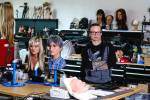Basement might hold hidden treasures
Look in the basement. Sometimes the old boxes of soap near the laundry tubs can be valuable.
This summer a 1950s full, sealed box of Rinso Blue soap powder that originally cost less than 50 cents, sold online at Mastro Auctions of Illinois for $1,955. It was because the box front showed a picture of Paladin, the star of the TV Western "Have Gun, Will Travel." And inside the box was not only soap, but also a very rare Paladin trading card.
The TV show was popular from its beginning in 1957 to the last of the 225 episodes in 1963. Paladin, played by Richard Boone, was a gunslinger who was available for jobs for $1,000. He enjoyed the good life in San Francisco, with the best of wine, food and clothes. But on the job he dressed all in black and chased the bad men. His memorabilia has become very popular with collectors, and because it is rare, it is expensive.
Q: I have a kidney-shaped mahogany desk with a leather top. It's in excellent condition and was made by the Maddox Table Co. of Jamestown, N.Y. Can you give me some information about it?
A: William Maddox, the son of an English immigrant, founded the Maddox Table Co. in 1898. He experimented with new advertising techniques by sending a showman around the world to promote his furniture and was one of the first Jamestown furniture makers to trademark his products.
The company made tables, desks and other case furniture. William Maddox invented all sorts of furniture-making machines, including a polisher for tabletops, and later founded a company to manufacture the machinery. His table company was sold to the Shearman Brothers Lounge Co. of Jamestown in 1919, and the Maddox name continued to be used until 1985.
Q: How much is Kay Finch's "Mr. Tom" figurine worth these days? Mine is marked "Kay Finch."
A: In 1939, Kay Finch (1903-1994) and her husband, Braden, built a small ceramics studio next to their house in Corona del Mar, Calif. The business was thriving within a couple of years and operated until 1962, the year Braden died.
Kay Finch animal figurines are enormously popular today. "Mr. Tom" dates from 1960 and only a few were made. They're big, seated tomcats, 18 inches high, and were decorated in different glazes. A "Mr. Tom" in excellent condition sells for more than $2,000.
Q: I have a Griswold No. 8 Dutch oven that's rusty and pitted. If I clean all the rust off and season it, will the pits affect how it cooks?
A: Griswold is a well-known brand of cast-iron cookware. The company was in Erie, Pa., from 1865 through 1957. Griswold skillets, muffin tins and other products were usually made of iron.
If you want to use the Dutch oven, clean off the rust. One method is to soak the pan in a 50 percent solution of white vinegar and water for a few hours (too long and the vinegar will eat the metal). Then you have to "season" the pot. Warm it in the oven for a few minutes, then rub vegetable oil, shortening, lard or bacon grease on the metal. Return the pot to the oven, set the temperature at 225 degrees and let the pot warm for 30 minutes. Remove any pooled grease, then put it back in the oven for another half-hour.
Pits or other physical damage should not affect the food cooked.
Q: Does my old "Lost in Space" robot have any value? It's red and black and is made mostly of plastic. I have the original box and instructions, too.
A: If your robot and its box are in excellent condition, and if the toy still runs when you put batteries in, you have a valuable toy that could sell for more than $500.
Your robot dates from 1966 and was sold by Remco Industries of Harrison, N.J., to fans of the TV series "Lost in Space." The series ran from 1965 to 1968 on CBS, and both the show and its licensed products still generate a lot of interest. The robot was made in red and blue or blue and black.
Your original box and instructions give your toy nearly half its value. Lithographed tin Japanese toy robots from the 1950s can sell for even more money.
Q: Please tell me how to care for an antique leather fire bucket decorated with painted letters and a scene.
A: From the late 1600s to the early 1800s, hand-sewn leather fire buckets were standard equipment in American towns. Many of them were painted with the names of homeowners or local fire companies. Buckets in good condition can sell for prices into the thousands.
The best way to care for your bucket is to display or store it in a place where the humidity is not too high or too low and the light is not bright. Don't use anything to clean it except a dust cloth. You could take paint off even with plain water.
If a bucket needs any restoration work, take it to a professional. Bad restoration lowers the value.
Tip: Scratches on plastic furniture can be hidden with regular applications of automobile wax.
Terry Kovel's column is syndicated by King Features. Write to: Kovels, (Las Vegas Review-Journal), King Features Syndicate, 888 Seventh Ave., New York, NY 10019.























